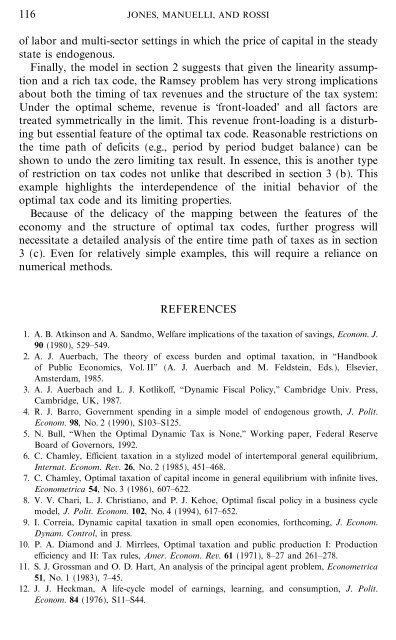On the Optimal Taxation of Capital Income
On the Optimal Taxation of Capital Income
On the Optimal Taxation of Capital Income
Create successful ePaper yourself
Turn your PDF publications into a flip-book with our unique Google optimized e-Paper software.
116 JONES, MANUELLI, AND ROSSI<br />
<strong>of</strong> labor and multi-sector settings in which <strong>the</strong> price <strong>of</strong> capital in <strong>the</strong> steady<br />
state is endogenous.<br />
Finally, <strong>the</strong> model in section 2 suggests that given <strong>the</strong> linearity assumption<br />
and a rich tax code, <strong>the</strong> Ramsey problem has very strong implications<br />
about both <strong>the</strong> timing <strong>of</strong> tax revenues and <strong>the</strong> structure <strong>of</strong> <strong>the</strong> tax system:<br />
Under <strong>the</strong> optimal scheme, revenue is `front-loaded' and all factors are<br />
treated symmetrically in <strong>the</strong> limit. This revenue front-loading is a disturbing<br />
but essential feature <strong>of</strong> <strong>the</strong> optimal tax code. Reasonable restrictions on<br />
<strong>the</strong> time path <strong>of</strong> deficits (e.g., period by period budget balance) can be<br />
shown to undo <strong>the</strong> zero limiting tax result. In essence, this is ano<strong>the</strong>r type<br />
<strong>of</strong> restriction on tax codes not unlike that described in section 3 (b). This<br />
example highlights <strong>the</strong> interdependence <strong>of</strong> <strong>the</strong> initial behavior <strong>of</strong> <strong>the</strong><br />
optimal tax code and its limiting properties.<br />
Because <strong>of</strong> <strong>the</strong> delicacy <strong>of</strong> <strong>the</strong> mapping between <strong>the</strong> features <strong>of</strong> <strong>the</strong><br />
economy and <strong>the</strong> structure <strong>of</strong> optimal tax codes, fur<strong>the</strong>r progress will<br />
necessitate a detailed analysis <strong>of</strong> <strong>the</strong> entire time path <strong>of</strong> taxes as in section<br />
3 (c). Even for relatively simple examples, this will require a reliance on<br />
numerical methods.<br />
REFERENCES<br />
1. A. B. Atkinson and A. Sandmo, Welfare implications <strong>of</strong> <strong>the</strong> taxation <strong>of</strong> savings, Econom. J.<br />
90 (1980), 529 549.<br />
2. A. J. Auerbach, The <strong>the</strong>ory <strong>of</strong> excess burden and optimal taxation, in ``Handbook<br />
<strong>of</strong> Public Economics, Vol. II'' (A. J. Auerbach and M. Feldstein, Eds.), Elsevier,<br />
Amsterdam, 1985.<br />
3. A. J. Auerbach and L. J. Kotlik<strong>of</strong>f, ``Dynamic Fiscal Policy,'' Cambridge Univ. Press,<br />
Cambridge, UK, 1987.<br />
4. R. J. Barro, Government spending in a simple model <strong>of</strong> endogenous growth, J. Polit.<br />
Econom. 98, No. 2 (1990), S103 S125.<br />
5. N. Bull, ``When <strong>the</strong> <strong>Optimal</strong> Dynamic Tax is None,'' Working paper, Federal Reserve<br />
Board <strong>of</strong> Governors, 1992.<br />
6. C. Chamley, Efficient taxation in a stylized model <strong>of</strong> intertemporal general equilibrium,<br />
Internat. Econom. Rev. 26, No. 2 (1985), 451 468.<br />
7. C. Chamley, <strong>Optimal</strong> taxation <strong>of</strong> capital income in general equilibrium with infinite lives,<br />
Econometrica 54, No. 3 (1986), 607 622.<br />
8. V. V. Chari, L. J. Christiano, and P. J. Kehoe, <strong>Optimal</strong> fiscal policy in a business cycle<br />
model, J. Polit. Econom. 102, No. 4 (1994), 617 652.<br />
9. I. Correia, Dynamic capital taxation in small open economies, forthcoming, J. Econom.<br />
Dynam. Control, in press.<br />
10. P. A. Diamond and J. Mirrlees, <strong>Optimal</strong> taxation and public production I: Production<br />
efficiency and II: Tax rules, Amer. Econom. Rev. 61 (1971), 8 27 and 261 278.<br />
11. S. J. Grossman and O. D. Hart, An analysis <strong>of</strong> <strong>the</strong> principal agent problem, Econometrica<br />
51, No. 1 (1983), 7 45.<br />
12. J. J. Heckman, A life-cycle model <strong>of</strong> earnings, learning, and consumption, J. Polit.<br />
Econom. 84 (1976), S11 S44.
















